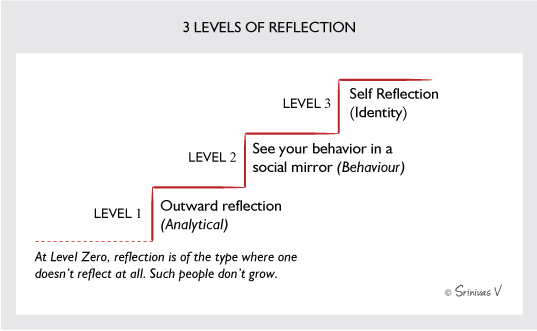There are 3 kinds of reflection.
Level 1: Outward reflection
I see some phenomena outside. I reflect on it and ask why it is happening. This is analytical reflection.
Here you think through the problem and understand the root cause with strong analytical & reasoning skills.
This is the first level of reflection that everybody learns while growing up.
Level 2: See your behavior in a social mirror
The second level of reflection is when you see your behavior in a social mirror. Here, if somebody doesn’t like your behavior, you try to modify it.
If people do not develop this, they keep making mistakes. They have social gaps, are dysfunctional in organizations and groups – because they are unable to learn the rules and protocols of engagement in a social systems. They are however quick to learn and adapt when people give them feedback. Then they grow with it.
A lot of high performers in organizations are at this level of identity.
It is at this level where people reflect on strengths & errors (e.g. SWOT Analysis). It is hard to move up the organizational ladder without learning this.
Level 3: Self Reflection
At this level, one is able to reflect and reconstruct one’s identity and sense of self. Very few people do this. Without this, Deep-rooted transformation does not take place.
Usually people grow till Level 2, and external success comes from here. However, external success does not solve the challenges of deep transformation.
Level 3 should not be confused with honesty. One can be very honest and still reach only till Level 2 – because one does not see oneself and the blocks in one’s consciousness. This comes through meditation.
If Level 3 is not there, people are not able to realize why, but they are unable to get deep fulfillment. Level 2 gives performance. And therefore the results of performance. But Level 3 delivers fulfillment.
Strategies for Level 3 Self-reflection
There are three strategies for Level 3 self-reflection:
One, Level 3 needs requires you to be able to go through the hell of facing yourself wholly and without illusions. To do this, you need Sraddha (or faith) – faith in yourself, faith in the Infinite. Or faith in an Acharya or a Guru – someone who is honest and will be able to do it for you.
Two, you could develop deep meditative capacities to get a deep inner awareness of identity. However, sometimes people with even 20 years of meditation are unable to do get here. They may get awareness of purity, impurity, etc. but not of identity i.e. “who am I” – which is the master question for deep inner awareness. It is not easy to answer this question, and even deeply perceptive people are unable to do this.
Three, commit yourself deeply and immerse yourself in a high and transformative ideal. The ideal then transforms your identity.
Day and night one works towards understanding that ideal and trying to live it. Because of this one’s identities keep churning. Out of sheer love and sheer will, and radical commitment to that ideal, the ideal will then suffuse your being and you will be able to undergo a deep shift. In short, you will obtain the results of self-reflection through directed self-transformation.


